The arrival of African American GIs liberating concentration camps and restoring towns and villages across western Germany and Austria shifted white-black relations in Central Europe. Although applauded and venerated by some, they were also feared and loathed by others. The wives, girlfriends, and lovers of African American soldiers experienced social shaming and stunning, especially if the result of their relations ended in the birth of a child. Trying to decide what to do with these “occupation babies,” many German officials encouraged adoption or for the children to be placed in orphanages and children’s homes. In the meantime, African-American servicemen and veterans settled and set up Black institutions and political organizations, and African students and activists in exile made West Germany a site for diasporic political organizing. These activities are not widely known, but they form an important component of Black activism and community-building in postwar West Germany.
In communist East Germany, the state established a message of solidarity with the continents of Africa and Asia and with the plight of African Americans in the United States who were part of the Civil Rights movements. The experiences on the ground of Black people in East Germany, however, often contradicted the East German State’s own message of socialist solidarity and racial equality.
Beginning in the 1980s, with the encouragement of Black feminist Audre Lorde, the children of this generation of “occupation babies” established the Afro-German movement that is still with us today. Through the foundation of organizations such as ADEFRA and ISD, Afro-Germans began to collectivize in great numbers to articulate their positions as Black Germans.
We are regularly developing new content. If you see an entry below without a link, that just means we working on the material, and we will make the page live when it is complete. If you would like information on these topics ahead of time, just email us and we’ll be happy to provide what we have ready.
Children of the occupation in West Germany
 Three Little Negroes (1951)
Three Little Negroes (1951) Academic Success of “Negermischlinge” (1956)
Academic Success of “Negermischlinge” (1956)
Solidarity of the peoples in East Germany
 I Shall Never Return – A Nigerian Student in Communist East Germany (1967)
I Shall Never Return – A Nigerian Student in Communist East Germany (1967) An African with her child (1961)
An African with her child (1961)
Creating Black spaces and communities
 The Penguin Bar, West Berlin (1949)
The Penguin Bar, West Berlin (1949) Founding a Black Information Center in West Berlin (1970)
Founding a Black Information Center in West Berlin (1970) Maishe Maponya and Bahamutsi Drama Group tour West Germany (1982-1983)
Maishe Maponya and Bahamutsi Drama Group tour West Germany (1982-1983) AWA Finnaba (1983-1988)
AWA Finnaba (1983-1988) “Black Germans are meeting up” in Wiesbaden (1985)
“Black Germans are meeting up” in Wiesbaden (1985) Black Cultural Festival, West Berlin (1986)
Black Cultural Festival, West Berlin (1986) May Opitz and John Amoateng talk about new Black German Groups (1987)
May Opitz and John Amoateng talk about new Black German Groups (1987) Karibuni Afrika Festival (1989)
Karibuni Afrika Festival (1989) ISD Bundestreffen, München (1989)
ISD Bundestreffen, München (1989) Tahir Della on the beginning of ISD (2017)
Tahir Della on the beginning of ISD (2017) Ricky Reiser on the beginning of ISD and her time as editor of afro look (2017)
Ricky Reiser on the beginning of ISD and her time as editor of afro look (2017)
Activism and protest
 African students storm a West Berlin cinema in a protest action (1966)
African students storm a West Berlin cinema in a protest action (1966) Fasia Jansen summoned for incitement of the people (1970)
Fasia Jansen summoned for incitement of the people (1970) Working for African Brotherhood Liberation in West Berlin (1970)
Working for African Brotherhood Liberation in West Berlin (1970)
Everyday racism
 Defining blackness (1980)
Defining blackness (1980) May Ayim, “afro-german I” (1985)
May Ayim, “afro-german I” (1985)
African Americans in West Germany
 J. Elmer Spyglass teaches West Germans about democracy (1947)
J. Elmer Spyglass teaches West Germans about democracy (1947) An African American soldier comments on being black in West Germany (1948)
An African American soldier comments on being black in West Germany (1948) Soldiers fight discrimination in West Germany (1950)
Soldiers fight discrimination in West Germany (1950) A German view of black soldiers in Munich (1951)
A German view of black soldiers in Munich (1951) Five soldiers relaxing in Berlin (1952)
Five soldiers relaxing in Berlin (1952) Soldiers with German wives face prosecution in Texas (1957)
Soldiers with German wives face prosecution in Texas (1957) Fighting racism in the US Army (1970)
Fighting racism in the US Army (1970)
German views of the American Civil Rights struggle
Cultural representations
 1 Berlin-Harlem (1974)
1 Berlin-Harlem (1974)

Hello, I’m trying to access some of the content above, but the hyperlink doesn’t appear and allow me to click for all the materials. Is there a reason for this?
LikeLike
Hi Melissa, sorry for the inconvenience on this. The items listed are still in progress and so haven’t been completed yet. But if you let me know what particular ones interest you I can provide you with what we have, with the proviso that they’re in progress of course. Best, Jeff
LikeLike